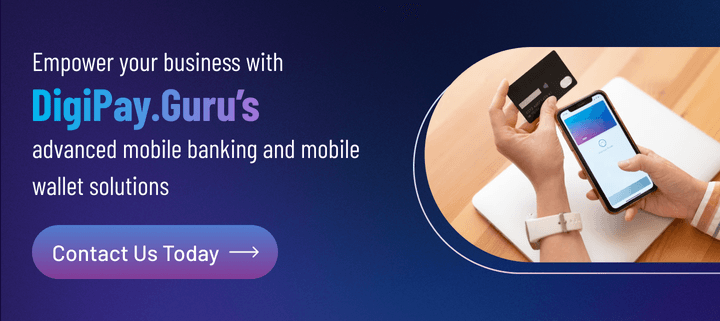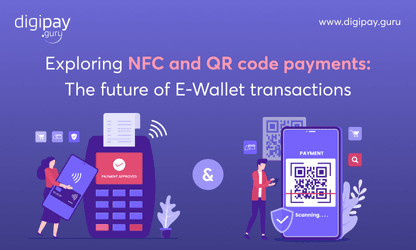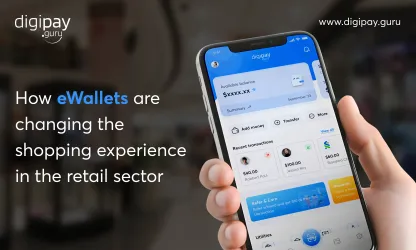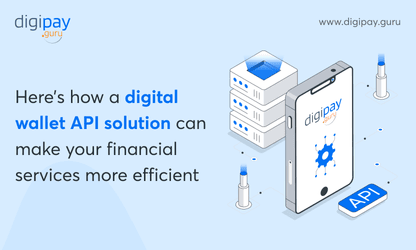With technological advances, mobile wallets, and mobile banking has become a very popular method of finance management. Both mobile wallets and mobile banking enable users to manage and access their financial data on their handheld devices, making it more convenient and seamless than ever before.
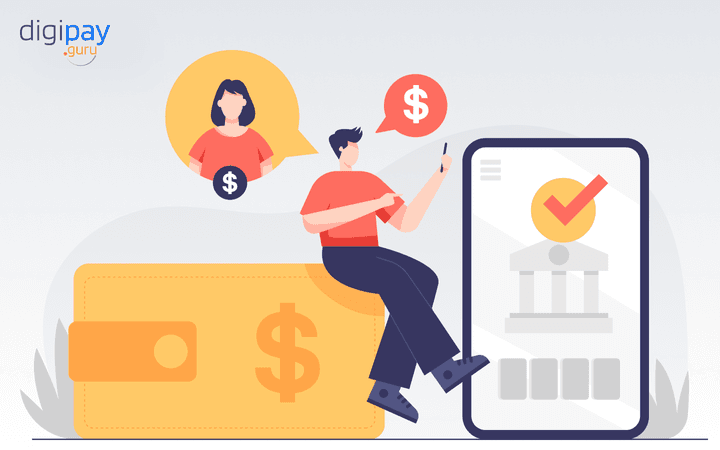
Nonetheless, despite their likenesses, mobile wallets, and mobile banking are two separate technologies with diverse features, functionality, and use cases.
In this guide, we will learn deeply about mobile wallets and mobile banking to help you comprehend the differences between these two technologies. We will also help you get a clear and concise overview of what mobile wallets and mobile banking are, how they work, and what makes them different from one another.
So, let's get started and explore the world of mobile payments together!
What are mobile wallets?
Mobile wallets, also known as digital wallets or mobile payment apps, are electronic versions of traditional wallets that allow users to store and use their credit and debit cards, loyalty cards, coupons, and other types of payment information on their mobile devices.
According to the latest study by statista, the global market for mobile wallets is expected to reach around 9419.6 billion dollars by 2025. This figure shows a significant increase and constant popularity of mobile wallets.
These wallets work by linking to users' bank accounts and can be used to make payments at participating retailers, both in-store and online. Some popular examples of digital wallet apps include Apple Pay, Google Pay, and Samsung Pay.
How Mobile Wallets Work
| Step 1 | Step 2 | Step 3 |
|---|---|---|
| User downloads a mobile wallet app and sets up an account | User links their credit/debit card information to the mobile wallet | User selects the card they want to use for the transaction |
| Step 4 | Step 5 | Step 6 |
| User holds their mobile device near the contactless payment terminal | The terminal uses NFC technology to communicate with the mobile wallet | Payment is processed automatically |
Pros of Mobile Wallets
Convenience: Mobile wallets eliminate the need to carry multiple physical cards, making it easier to manage finances on the go.
Security: Mobile wallets solution use advanced security features such as tokenization and encryption to protect users' personal and financial information. This ensures a secure online payment system for the customers.
Read more: Protect your customers with a secure online payment system
Speed: Mobile wallets allow for fast and easy payments, eliminating the need to physically hand over credit or debit cards.
Rewards and discounts: Some mobile wallets offer rewards and discounts for using the app to make payments. Whereas, some come up with loyalty and reward programs.
Digital Record: Transactions made through mobile wallets are saved digitally which makes it easy for the user to keep track of their expenses.
Multi-currency support: Some mobile wallets allow users to store and use multiple currency cards, making it convenient for international travelers.
Increased acceptance: Many merchants now accept mobile wallet payments, making it a widely accepted form of payment.
Contactless payments: Mobile wallets enable contactless payments which reduce the risk of transmitting germs and the spread of disease.
Cons of Mobile Wallets
Limited merchant acceptance: Not all merchants accept mobile wallet payments, which can be inconvenient for users.
Dependence on a mobile device: Users need a mobile device with an internet connection to access and use their mobile wallets.
Vulnerability to hacking: Mobile wallets can be vulnerable to hacking and other types of cybercrime, so users should be cautious and keep their mobile devices secure at all times.
Additional fees: Some mobile wallets may charge additional fees for certain services.
Battery dependency: Mobile wallets require a charged battery to function, and if the device runs out of battery it can't be used.
Limited to specific platforms: Some mobile wallets are only available in specific countries, making them not available for international users.
Limited to specific countries: Some mobile wallets are only available in specific countries, making it not available for international users.
Data privacy concerns: Storing personal and financial information on mobile devices can raise data privacy concerns.
What is mobile banking?
Mobile banking refers to the ability to access and manage your bank account(s) and financial information through a mobile device such as a smartphone or tablet. This includes a wide range of services such as checking account balances, transferring money, paying bills, depositing checks, and managing account settings.
How Mobile Banking Works
| Step 1 | Step 2 | Step 3 |
|---|---|---|
| User downloads a mobile banking app or accesses a mobile-optimized website provided by their bank or financial institution | User enters their login credentials to access their account information | User can now access and manage their account information and perform transactions such as checking account balances, transferring money, paying bills, depositing checks, and managing account settings |
Pros of Mobile Banking
Accessibility: Mobile banking allows users to access their account information and perform transactions anytime, anywhere, as long as they have an internet connection.
Convenience: With mobile banking, users can perform transactions such as checking account balances, transferring money, paying bills, depositing checks, and managing account settings without visiting a physical bank branch or ATM.
Security: Mobile banking utilizes advanced security features including biometric technology in digital payment (for authentication), tokenizations, encryption, and multi-factor verifications to protect users' personal and financial information.
Real-time updates: Users can get real-time updates on their account transactions, balances, and other information.
Digital Record: Transactions made through mobile banking are saved digitally which makes it easy for the user to keep track of their expenses.
Easy account management: Mobile banking allows users to easily manage their account settings and preferences.
Widely available: Most banks and financial institutions offer mobile banking services.
Lower costs: Mobile banking can reduce the cost of traditional banking services such as check depositing, money transfer, and account management.
Contactless payments: Mobile banking enables contactless payments which reduce the risk of transmitting germs and the spread of disease. This came to light and was implemented full-fledged during the time of the Covid-19 pandemic.
Read more: How contactless payments drove digital payments during Covid-19
Better budgeting and tracking: Some mobile banking software or apps offer budgeting tools and the ability to view account transaction history which can help users better track and manage their expenses.
Cons of Mobile Banking
Security concerns: Mobile banking is vulnerable to hacking and other types of cybercrime, so users should be cautious and keep their mobile devices secure at all times.
Limited to specific devices: Some mobile banking apps and websites may not be compatible with all devices.
Limited to specific platforms: Limited to specific platforms: Some mobile banking apps are only available on specific platforms (iOS, Android) and not all devices support all mobile banking apps.
Limited to specific countries: Some mobile banking apps are only available in specific countries, making them not available for international users.
Technical issues: Mobile banking may be prone to technical issues such as system downtime or app crashes, which can cause inconvenience to users.
Limited services: Some banks and financial institutions may not offer all the services that a user may need through mobile banking.
Dependence on internet connection: Users need a stable internet connection to access and use mobile banking services.
Battery dependency: Mobile banking requires a charged battery to function, and if the device runs out of battery it can't be used.
Limited paper trail: Transactions made through mobile banking are saved digitally, which may not be ideal for users who prefer a paper trail.
Data privacy concerns: Storing personal and financial information on mobile devices can raise data privacy concerns.
Differences between Mobile Wallets and Mobile Banking
| Mobile Wallet | Mobile Banking |
|---|---|
| Storing and using payment information (credit/debit cards, loyalty cards, coupons) | Accessing and managing bank account(s) and financial information |
| Use of advanced security features such as tokenization and encryption | Use of advanced security features such as biometric authentication, encryption, and multi-factor authentication |
| Quick and easy way to make payments | Comprehensive account management and various services such as checking account balances, transferring money, paying bills, depositing checks and managing account settings |
| Accepted by a growing number of retailers | Generally accepted by all banks and financial institutions |
Both mobile wallets and mobile banking offer convenient ways to manage one's finances, but the two technologies have distinct features and functionality. Mobile wallets focus primarily on the storage and use of payment information, while mobile banking allows users to access and manage their bank account(s) and financial information.
Mobile wallets use advanced security features such as tokenization and encryption to protect users' payment information. Mobile banking, on the other hand, also offers advanced security features such as biometric authentication, encryption, and multi-factor authentication to protect users' financial information and transactions.
Mobile wallets offer a quick and easy way to make payments, while mobile banking offers a wide range of services such as checking account balances, transferring money, paying bills, depositing checks, and managing account settings.
One key difference between mobile wallets and mobile banking is merchant acceptance. While mobile wallet payments are accepted by a growing number of retailers, not all merchants accept them yet. Mobile banking, on the other hand, is generally accepted by all banks and financial institutions.
So, if you're looking for a convenient and secure way to make payments, a mobile wallet may be the perfect solution. However, if you're looking for more comprehensive account management, mobile banking could be the way to go.
Conclusion
We have seen that both mobile wallets and mobile banking offer convenient and secure ways to manage one's finances, but they have distinct features and functionality. Mobile wallets focus primarily on the storage and use of payment information, while mobile banking allows users to access and manage their bank account(s) and financial information.
So, it's clear that the choice between a mobile wallet and mobile banking will depend on your individual needs and preferences. For a convenient and secure way to make payments, a mobile wallet may be the perfect solution. However, for more comprehensive account management, mobile banking could be the way to go.
We at DigiPay.Guru, offer both advanced mobile money solutions, i.e. mobile wallets, and mobile banking to cater to your diverse needs. Our digital wallet solution is designed to be secure, easy to use, and accepted by a wide range of merchants.
Whereas, our mobile banking solution is designed to provide you with comprehensive account management and various services such as checking account balances, transferring money, paying bills, depositing checks, and managing account settings.
